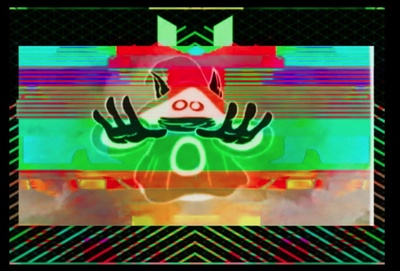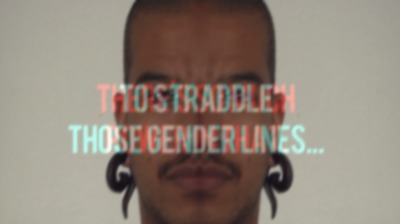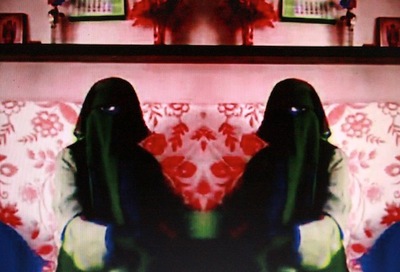A New Cosmic Mix: Now in 5D! An Interview with Maggie Cavallo

Image: Hexbeam courtesy of the artist
Maggie Cavallo is an experimental curator and educator based in Boston, MA. Committed to celebrating and contextualizing contemporary art in Boston and beyond, Cavallo specializes in live and experiential aesthetic experiences. Recent projects include ☢ SPACE CASE: ZILLABOSTON ONLINE RESIDENCY, NEAR DEATH performance art experience curated by Vela Phelan, NOTHING & NO THING curated by Robert Yoder and INSTANT MESSAGING co-curated with Anthony Greaney. Cavallo is also Curator of Education at Montserrat College of Art, where she programs over fifty visiting artists into the curriculum each semester. Her latest project is A New Cosmic Mix: now in 5D! at the Museum of Science’s Charles Hayden Planetarium May 12th at both 630 pm and 830 pm. We spoke recently.
Robert Moeller: The 5th Dimension is heady stuff. What should people expect from a project that fuses so many ideas together and projects them out onto the ceiling of a planetarium?
Maggie Cavallo: Primarily, I see myself as responsible for recognizing trends and patterns in contemporary art and facilitating experiences with these occurrences for audiences (rather than didactic lessons or messages). This takes the edge off when I start to have anxiety about whether an audience will walk away actually “understanding” the 5th Dimension. Instead, I consider it this way: Yassy Goldie currently exists in the 5th Dimension and offers audiences a framework for understanding that experience. This means, at the very least, that after the performance our audience will consider that the 5th Dimension actually exists. I’ve brought these artists together to activate the audience, to open them up to these heady ideas and to ideally encourage them to look more closely, think more critically and ask more questions.

Loose by DhanaPerry, video still
RM: More specifically, the questions asked by the audience might drift in what direction?
D’hana Perry’s experimental documentary, LOOSE, is a great example of content that I see as able to cause a change in modes of perception. In an interview, one of Perry’s subjects describes their experience of being transgender as “out of body” and being “tapped into” a knowledge that few others understand. For audiences who are less familiar with the experiences of the transgender community, but have a way of relating to the concept of “out of body”, the result can be a new mode of perceiving and understanding this identity. I imagine each exhibit I curate within the context of all the other experiences an audience member will have that day, or year, or lifetime…. how can the experience of A New Cosmic Mix relate to and affect all the experiences that will follow it?
RM: Implicit in the act of looking up is a rendering of our “smallness” and our rather insignificant imprint on the universe. Is that too present in the mix?
MC: There is this idea that we look up to the sky for answers, we wish on shooting stars, we imagine that there is something else out in the “beyond”. I am thrilled by the idea of an audience sitting back in the planetarium seats, and looking UP. Locked in. Looking for answers. If the event proves to be successful, audiences can expect to transcend beyond common experiences and find the answers they are looking for: connections between our identities, our bodies and the cosmos. (I’ve been using the term ‘cosmos’ to refer to anything outside of us, and our physical experience here on earth. Meaning: space, other dimensions, spirituality, and the unknown.)
RM: How did the idea originate? Did the venue sculpt the approach or was it the reverse?
MC: I had a budding concept for this program about a year ago, the initial inspiration coming from live video and sound that was being presented in both art and non-art spaces. BATHAUS often performs in music venues or alongside performance artists in art venues. Vela Phelan’s HEXbeam was often shown alongside sound performances by other artists or in clubs during events like Picó Picante. I wanted to
isolate these works in a new context, so audiences could really focus on the aesthetic decisions the artists were making. Around the same time Bobby Andres invited me over for a studio visit. I was expecting to look specifically at documentation of performance and was blown away by the scope of their work (installation, sculpture, video). At one point they dropped some theory about techno music on me, making me envision this sound as a drug that we consume and how it alters us. It was at that point that I knew I really wanted to work with them. I first
knew of D’hana Perry from the club scene in Boston & NY and had heard them do some great DJ sets, but when I discovered their practice and realized they were reinventing the Documentary by live remixing audio and video interviews of transgendered people of color, I was committed to showing that work alongside like-minded artists and within an aesthetic context specifically.

BATHAUS courtesy of the artist
RM: Talk about the logistics of it all.
MC: A few months ago, Alexis Avedisian the Art Coordinator for Together Boston approached me to curate an exhibition. Together is an annual electronic music festival, and Alexis manages a series of exhibits that take place in tandem with the festival, usually with a focus on art and technology. The timing was perfect, this performance needed a home and thanks to Alexis and the tireless staff at Together, they were able to lock down the Charles Hayden Planetarium at the Museum of Science. Because the artists work in live sound and projected image, using an array of new and dated technologies, it was a perfect fit. The MoS staff has been so helpful. One of my favorite elements of this program is that Darryl Davis, the Planetarium Systems Coordinator for the MoS, is actually collaborating with us on background imagery that will surround our projections. Our mix got a lot more cosmic, and we were so excited to have him be a part of the performance and also to pay tribute to the social history of the planetarium. People used to love to go to the planetarium to watch live laser shows to their favorite music, it feels really good to be bringing that back and maybe keep it going in the future. I developed a structure (or set list) for the event, which was enhanced by the artists’ input. And the approach to making the idea a reality within the space was due to the technical direction of Vela Phelan. It was important to me that the “live” nature and “mix” were not illusions, so we have sections where the audio of one artist meshes with the video of another and so on.
RM: The project feels both fully formed and ready to expand, sort of like a metaphor for the universe itself.
MC: Once Alexis invited me to curate an event for Together, I was pushed to put into words all my thoughts on the relationships between these artists, to define all these instinctual feelings into text. While I was able to write out the necessary text and press, the idea is still evolving and will continue to evolve during and after the performance. I decided to invite Yassy Goldie only a couple months ago after listening to their radio show from 12/17 on Somerville Free Radio, and realizing that their current works and experiences were fitting right into the thematic development of A New Cosmic Mix. I’ve worked with Yassy, before and I sort of felt like – why hadn’t I thought of this sooner?? But I think exhibits are sort of just out there waiting to be put together, it usually works out if you have faith in your curatorial instinct, keep your eyes peeled and have patience and professionalism.
RM: There is a sense, too, that you are riffing off sort of formative drug culture moments like getting high and going to the laser-light show at the planetarium, nostalgia, perhaps?
MC: Absolutely. And nostalgia for that type of culture at a planetarium specifically was not part of the original concept, but a totally appropriate addition and the artists and I have been really excited to be a part of that history. I never experienced the planetarium in that way, but a dear friend of mine who used to be a Laserist for the Charles Hayden Planetarium recently described how only a ten years ago (or so), it was definitely the place to be. And there is a lot of similarity actually, in how laser shows used to be run (using a mixer to project and change the laser beams) and the way the Cosmic artists are running their sound and video. These days the system is completely computer operated, but I am looking forward to seeing some artists bring laser mixers into their work at some point – both in, and outside of the planetarium setting.
Your question also connects to the hallucinogenic nature of some of the imagery, especially in Phelan’s HEXbeam and also the relationships between the uses of hallucinogens to achieve a higher state of being in religious, spiritual and contemporary social contexts and the visual effects of being altered in this way.
RM: With so many components swirling around (literally) how hard was it to gain a fixed notion of the project or was that even necessary?
MC: I think the answer lies in a healthy combination of an instinct to refine, while still allowing room for growth. The most important elements of this performance for me: the liveness, a literal mix of those who mix on multiple levels, the thematic references that tie the artists together, a relationship with traditional performance art and non-art specific spaces, have all remained steadfast. But being open to developments and changes, has allowed for the work to grow stronger. For example, originally the idea of including moving imagery behind our projections from the Museum of Science’s Sky-Skan system felt completely wrong to me, as I was worried about it diminishing the integrity of the artists’ images. But since we allowed ourselves to experiment with the idea, it became apparent that this element enhanced the project in all the right ways.
RM: The refinement you speak of, is that a measure of curatorial restraint or the sheer expansiveness of the ideas present in the piece.
MC: If the projects that you curate are expansive, then the refinement is less of a restraint than it is a necessary skill. How do you edit and when do you expand? How do you ensure that concepts circle back and are reinforced? What language do you use to describe, contextualize and promote the performance? It’s “curatorial” in nature, for lack of a better word. But it also involves understanding how people learn (or the aesthetic experiences between audiences and art), and remembering the effects that you want to have as a result of organizing and presenting the work.

Bobby Andres video still, 2013
RM: As an appendage to the project, how much has the technology available at the planetarium changed or reshaped some of your original concepts about the work?
MC: The only technology utilized from the museum that altered the original plan was the addition of Darryl Davis’ background imagery behind the video content. During our first visit in February, Vela and I wanted to identify whether we would be able to tap into the Museum’s projection system. Because of the relationship between the projectors and their computer system Sky-Skan, this wasn’t possible. This ended up being an advantage, as all the artists would have to have created video for a hemisphere, rather than a rectangle. The learning curve and amount of work for each artist has already been very high, and this may have proved to be too much with the amount of time that we had. Instead we are using four independent projectors, whose beams will be framed by the Sky-Skan imagery live mixed by Darryl. Other than that, the only other assets utilized have been the architecture itself, the collaboration of museum staff, tapping into the planetarium audio system, borrowing a few small lights and black cloths.
RM: And finally, is it fair to say that in the act of “looking up” your hope is that the audience actually discovers the art of “looking around”?
MC: It is my hope that the event causes viewers to transcend the experience of “looking” to an experience of “seeing”. The audience is going to be a diverse group: artists, colleagues and fellow curators, fans of the planetarium and the museum of science, those that were brought in out of interest in Together; the format of the event is a chance to share time-based work with this varied crowd. The opportunity to spend ninety minutes with a performance is a unique one for most people, and I would like to imagine that this event will encourage them to take the time to engage with more live works in the future.
For More Info: Press Release | A New Cosmic Mix: now in 5D!
For Tickets & Updates: INVITE: A New Cosmic Mix: now in 5D!
Together Boston: www.togetherboston.com
Robert Moeller is the website coordinator for Art New England
